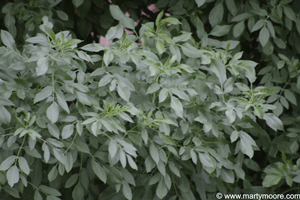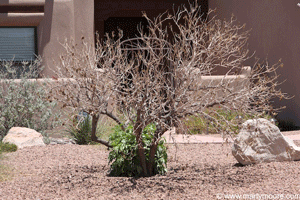Mexican Elders are fast growing trees and reach heights of around 20 feet in the desert Southwest.
They require full or partial sun and moderate watering. Leaves tend to scorch and drop in really hot weather, but the tree will usually perk up when the temps cool down.
These small shade trees are great for patio gardens and Southwestern landscapes.
Flowers are light yellowish and borne in clusters, followed by small dark berries. Birds really like the berries.
Mexican Elders have very soft wood and branches can break in heavy winds. They are usually pruned into a "mushroom " shape and this makes the tree very top-heavy. Staking may be necessary in loose soil and windy areas.
Many of the Mexican Elder trees took a hard hit around Las Cruces, NM this past winter when the temps got down to below zero. Many died back, but are coming back from the roots.
If this has happened to your Mexican Elder, don't just have it removed. The tree is such a fast grower, you can remove the dead top and pick two or three sprouts as new trunks and grow your own multi-trunked tree!
However, don't burn the wood or leaves, as they contain organic cyanide and breathing the smoke could give you cyanide poisoning.
The only insects we ever found on them were aphids, but we have seen problems with trees getting that "half dead" look in the summer, from being in too much heat or without enough water.
If you are contemplating planting a Mexican Elder tree, look around your neighborhood and see whether others in your area are doing well, if they are you will probably be OK, but if not, I would pick another type of tree.

2a.gif)

